4. Biofabricating Dyes and Materials#
This week Cecilia Raspanti illustrated different ways to dye fabrics with natural colors and create bioplastic fabrics, always using natural materials of both animal and vegetable origin.
Unfortunately, my classmate and I, do not have the chance to test bacterial cultures.
Wednesday#
Last Wednesday’s lesson with Giorgia Petri was carried out by testing the natural colorants first.
The mordents available are alum and water iron and copper left to stand for months with the same ingredients without chemicals additives.

The fabrics are different cottons, one of which has a cruder weave, organza, jersey and some cotton and wool threads.

The dyes available are turmeric, hibiscus, madder and annatto.

The fabric was boiled in water with the mordant according to the quantities indicated in the recipes. Having used both vegetable and animal fibers, we have a medium mixture, 15% of the weight of the fabric for about one hour.
We boiled The hibiscus flowers for about an hour and a half, the madder for about an hour, while the turmeric and the annatto were in powder and we diluted them in boiling water but still left many residues.
While the fabrics remained soaking in the colors we began to create the bioplastic according to Cecilia’s recipe.

Greta brought a prickly pear leaf that she found dry and cleaned, peacock feathers and dried bergamot peel that we used as decoration.
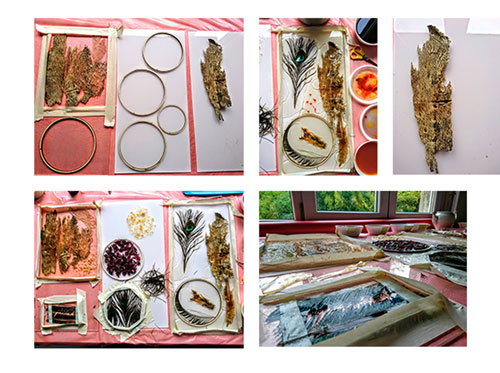
Shortly after the drafting, the bioplastic started to thicken and solidify and we started experimenting by making bubbles inside, inserting some color and using a surplus of bioplastic already coated that could not be poured on the plexiglas surface and decorated with bergamot.

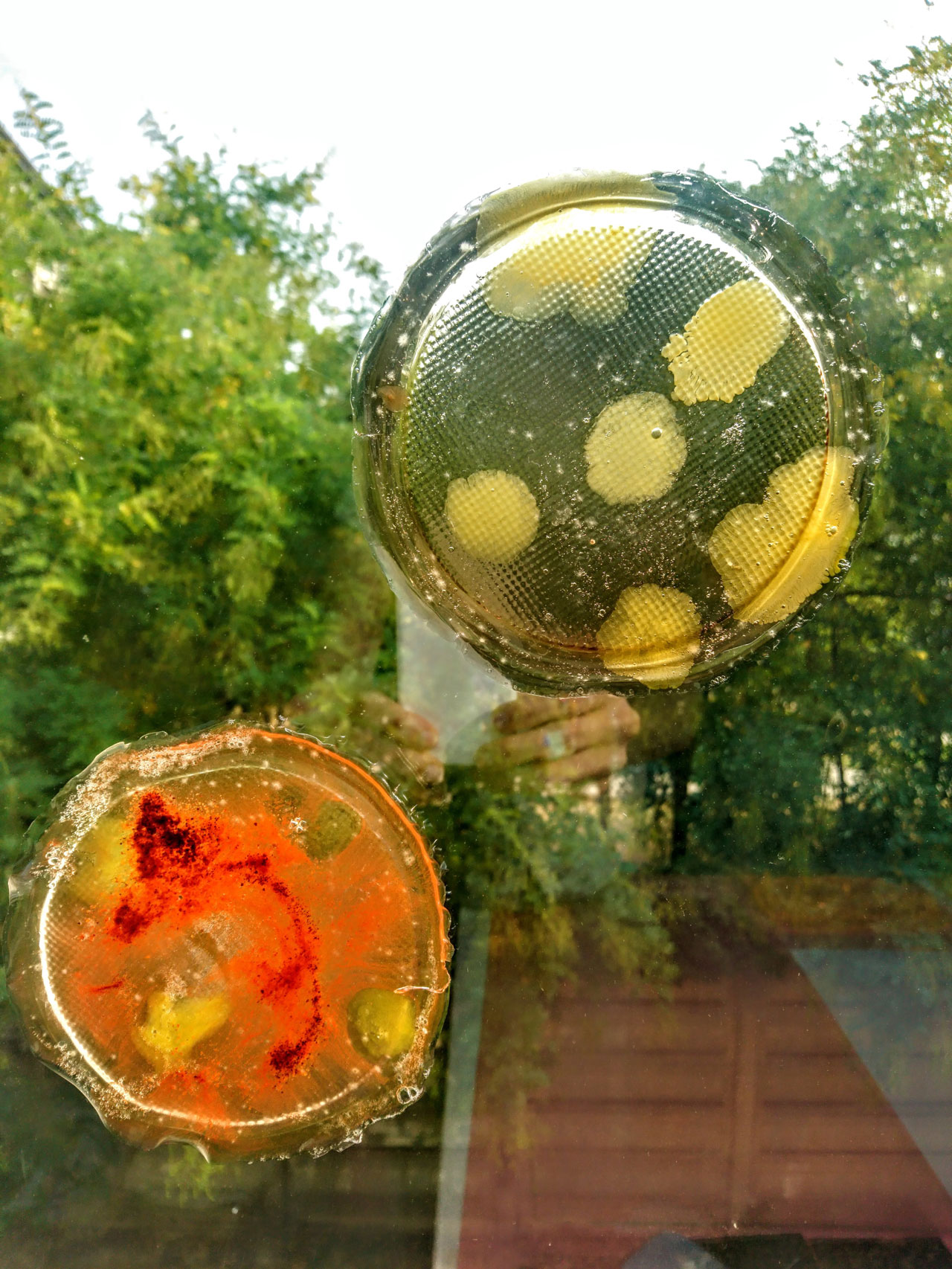
I poured some new bioplastic on my worktop where already there was a layer that was not enough and we did the same on bioplastic with bergamot but only half, to see the difference in texture.

At the end of the morning …

for work commitments my colleague and I shared the job. In the afternoon Greta,continued to make the basins of color with the bites that were missing between those made together and prepared the container for the Kombucha that she had already had to do for the degree theses.
ALL THIS FORM ME WAS NEW AND VERY EXITING!!!
All day on Thursday we left things to rest while on Friday morning I went to check the bioplastics, to turn them and to rinse the tissues and spread them.
Friday#
First of all I tried to detach the bioplastics from the Plexiglas. In my case the area included several objects and I had imagined being able to trim it and so it was. I used some common scissors.

For some of these, it was not easy to remove them. For example, the one with the bergamot, perhaps because it was very thin on the edges, was very attached to the surface. Where there was the peacock feather instead the bioplastic did not pass under the feather in some places making glue on part of the feather. To detach them I decided to use a common flat and wide kitchen utensil.
After shooting all the pieces of bioplastic we had done together, I went through rinsing the colored pieces including those that Greta had done on Wednesday afternoons.
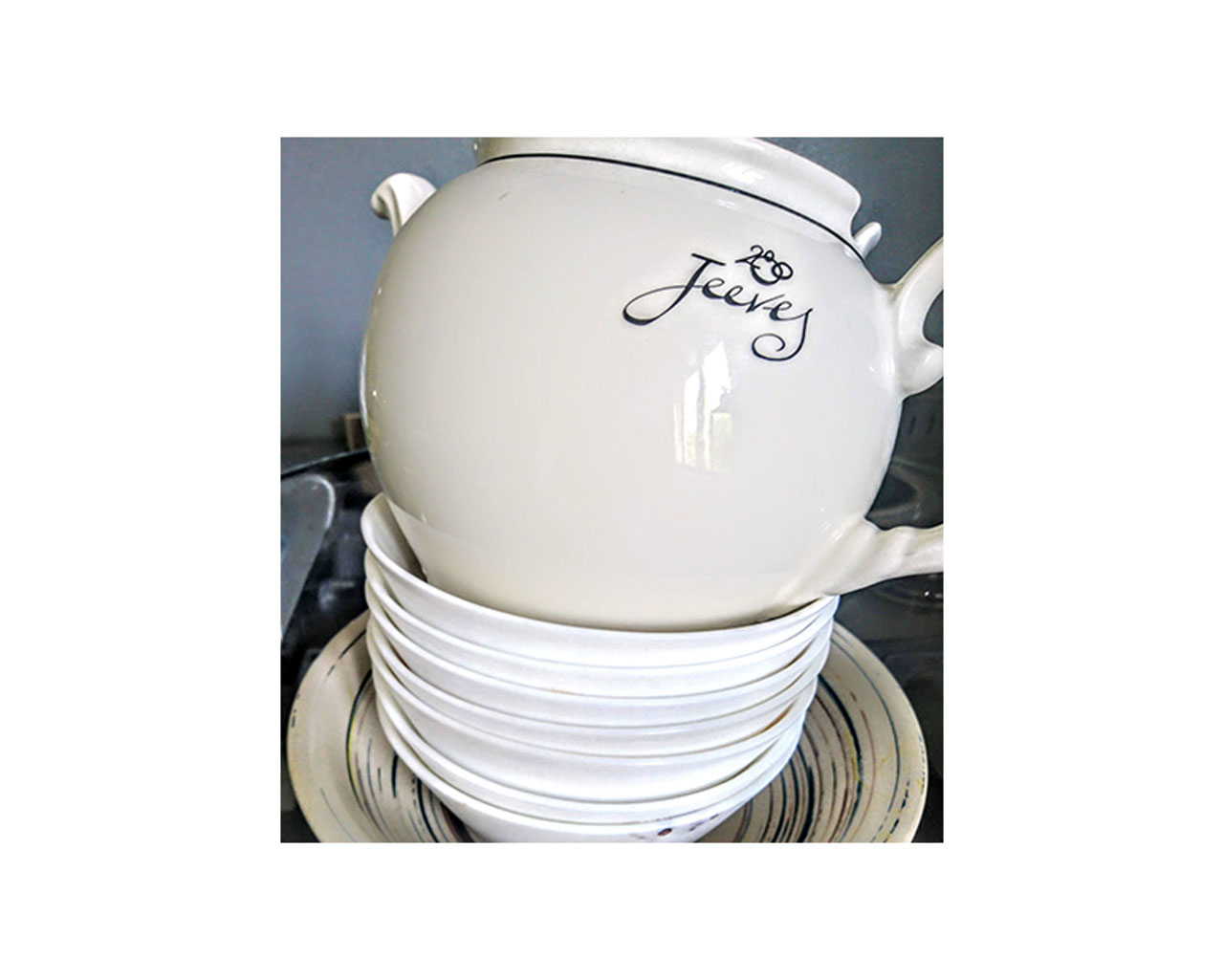
FIRST CONSIDERATIONS#
ANNATTO#
with copper and soda and with iron and soda it gave way to absorb the color of an intense aranione well. Copper and iron water had been resting for about eight months, with merely copper and iron matrices inside. not knowing how much effect they would have had as a mordant we used an indefinite amount compared to the recipe. That is a drop of an eye compared to the amount indicated. The annatto with alum made according to the procedure and the quantities indicated did not give good results. The color is not homogeneous and fills a faded yellow.

MADDER/ROBBIA#
with copper from a beautiful color but not uniform, a piece in particular has absorbed the color, but all seem to be cotton, perhaps this is more raw as a texture almost a linen. It should be understood if it also contains silk in this case would mean that the fiber of animal origin absorbs better than the vegetable one. with alum and soda the color does not remain homogeneous yet and the cotton like the jersey almost did not absorb at all. Perhaps the soda. Still the raw fabric remains the one that most of all has obtained an intense purple. with iron the color is lit the jesey has an intense purple color, minus the cotton, the raw fabric and the cotton and wool threads. In this case it would have to be checked whether it is the soda that decides the fate of the fabrics or if on the basis of the mordant that in the case of iron and copper are also modifiers, they dictate which fabric best takes the color. In practice, with copper and alum, the raw fabric absorbs better, with iron the jersey wins.

IBISCUS#
with alum the fabrics including the wool and cotton yarns have practically not taken color except for the silk-like organza that would confirm the theory above. in the same situation but with the addition of soda the water immediately became very dark and the wires seem to have simply made a shampooed wash. during the rinsing in the water there were pieces of very dark viscous material as if the soda had regained the color in different points. with copper the threads once again have no color, the organza has taken a purple color 227x227 would seem like with the alum while the jersey has assumed a much softer color of the same color. with iron the same situation presents itself but in the sun the organza seems to present a slightly more purple tone.

TURMERIC/CURCUMA#
with alum, everything absorbed a lot by taking an intense yellow color, the cotton thread absorbed well and was almost orange. with copper the colors are equally uniform of an intense yellow and the same result is obtained with the cotton thread that is almost orange.
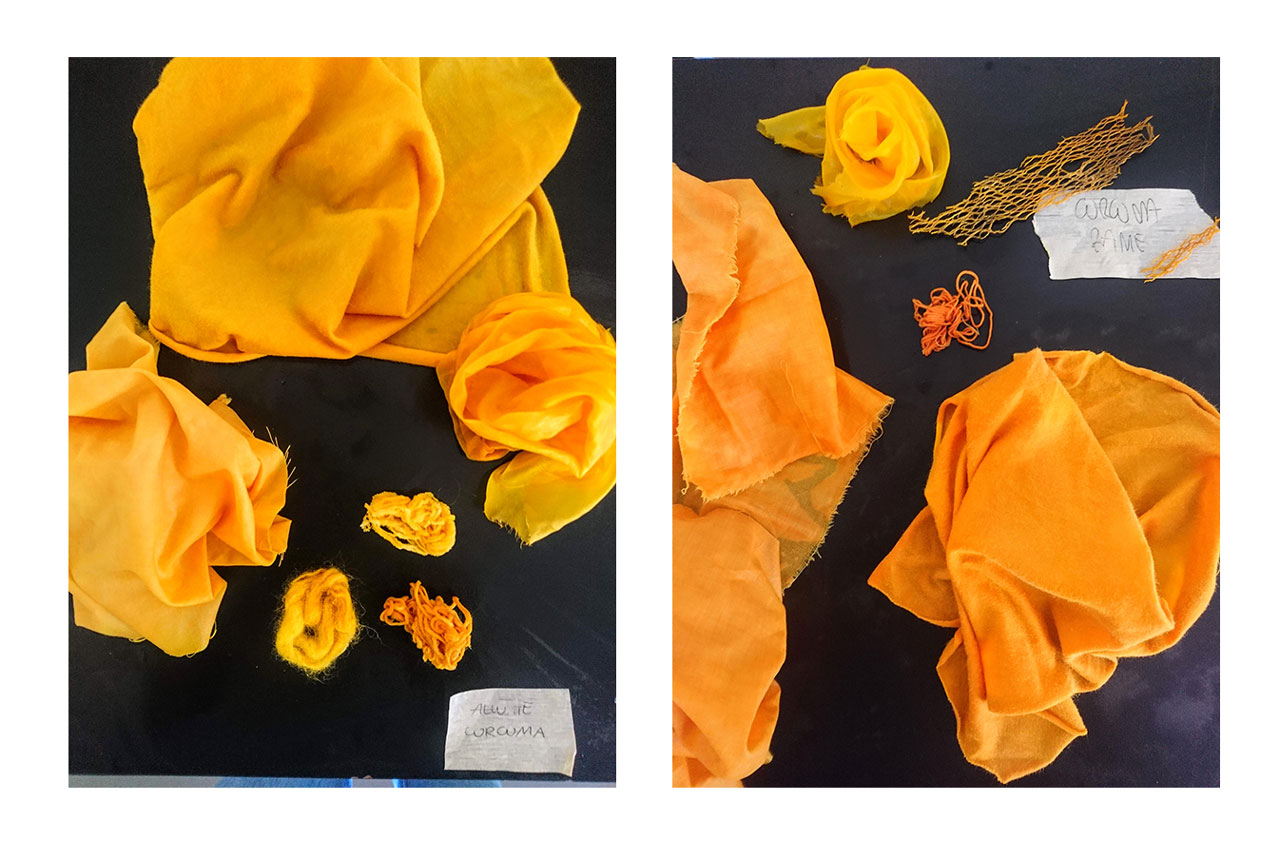
NOTE:#
The madder colored my fingers very much and the turmeric dyed yellow nails that I find very interspersive considering it is a light and natural color. Both the turmeric and the annatto were in powder and both left a lot of residue in the water.
KOMBUCHA#
greta has prepared a rather large container with:
1 lt water
5 gr the / 2 tablespoons
70/100 grams sugar
1 tablespoon vinegar
it already smells a little:D

SATURDAY TESTS: SECOND ROUND#
Saturday#
Greta and I agreed on new materials to be tested for coloring fabrics and for new bioplastic recipes.
What we used are black cabbage, beetroot, onion skin and saffron. Also for dinner I cooked spinach and decided to bring the water to be tested as a natural colorant even with salt and oil.
Recipes#
- Onion
500 ml water
1 cup onion skin
- Purple cabbage
2 L water
1/2 cabbage (500gr)
- Saffron
0,3 gr saffron
250 dl water

And fascinated by the color of purple cabbage I decided to let the leaves dry at about 80 degrees in the oven for a few hours. However, they have lost their bright color but are still very beautiful.

I was very struck by the intense blue color that took the water with purple cabbage, and very enthusiastic about the coppery color of the onions.
Both of us did not expect such a poor result with beet. The color of the water was not very bright and after washing the patches we realized that they had practically not taken color.
The purple cabbage on the other hand has left a light blue color on the cotton and the oganza has proved to be indisputably the best fabric among those available.

Saffron resulted in a faint but homogeneous yellow while the onion left a bright yellow color on the rust organza.
Some fabrics were kept immersed only with a piece of cloth. We had little colored water and this allowed us to evaluate a possible shade of color.
After lunch we made other bioplastics.
Those created a few days earlier, after several days, began to have mold on the surfaces despite the alcohol.
The environment at the fablab does not help, it is too humid and it is not a season when the sun heats a lot.
The consistency is soft and plastic.
The first recipe we wanted to test was the bioresin. We both wanted to test a consistency that would be more rigid.
To do this we followed the recipe by putting less glycerine.
The shapes I wanted to create are cubic-shaped containers of different sizes that fit one inside the other in one verse while stacking the smaller one on the base of the larger one forms a tower. It’s a very simple game for young children, from which I never wanted to separate.
To make the containers it was necessary to create the base in five steps, keep the rest warm, waiting for the base to solidify enough to turn the cube upside down and pour the bioresin on one side, this on all four sides.
To make sure that it did not leak outwards, I put a piece of paper tape so that the bio resinaliquida is not decanted.
I continued this process while creating other biosilicone and cooking another bioresin to form all the cubes.

To enrich the color of the container each cube is adorned with a different natural matrices such as licorice, scalloped chili, fnocchio seeds, black pepper and so on …
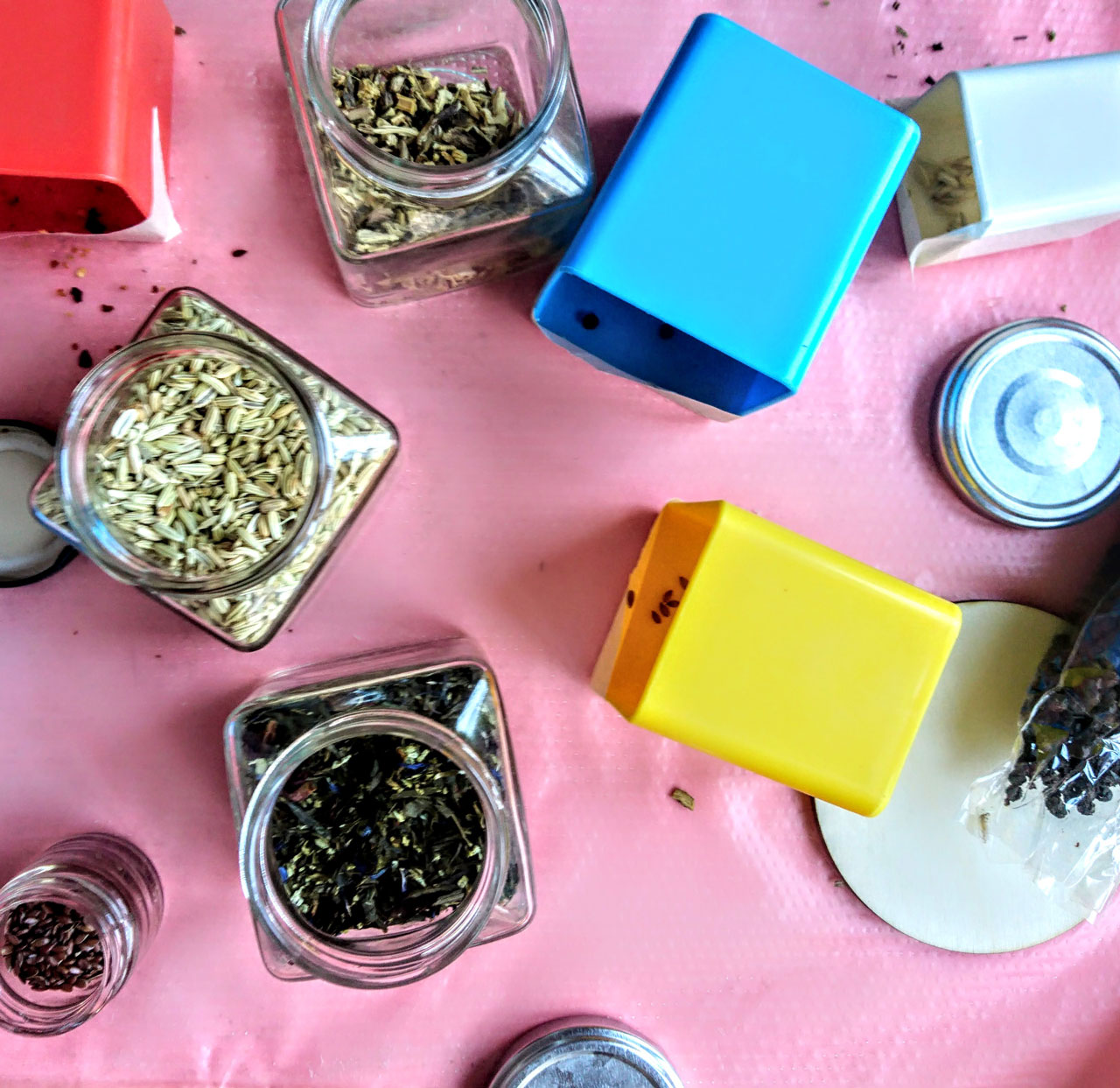
Later we decided to create biosilicone with materials that could replace water.
The liquids that we used were the crisp, mint syrup, and black tea that we decorated at paicimento.
we imagined this material of a consistency such as to imagine it as an addition to a hypothetical dress, we decided for this to set a geometric shape different from the circle.
I tryed to use this kind of biosilicone in one earring that i found during that morning in the street! Was so fun for me couse i thought about earrings with different kind of bioplastic!

In the evening I decided to quickly make the recipe for Greta that I wanted to do and in the hurry to close the fablab, I decided that I wanted transparent and I replaced the starch with jelly.
- The recipe was:
80 gr water
20 gr jelly
10 grams of vinegar (which actually came out triple)
10 gr of glycerine
While I cooked it in boiling I added some flakes of orange peel that I had brought from home.
The original recipe at some point solidifies in cooking while with gelatin it was not possible.
I spread it on baking paper even if it was not necessary. In the case of the original recipe being immediately glue to roll it, use two sheets of paper and spread it with a rolling pin. Non-existent my liquid I wanted to try to do the same in this way and also I put a little even in a circle.
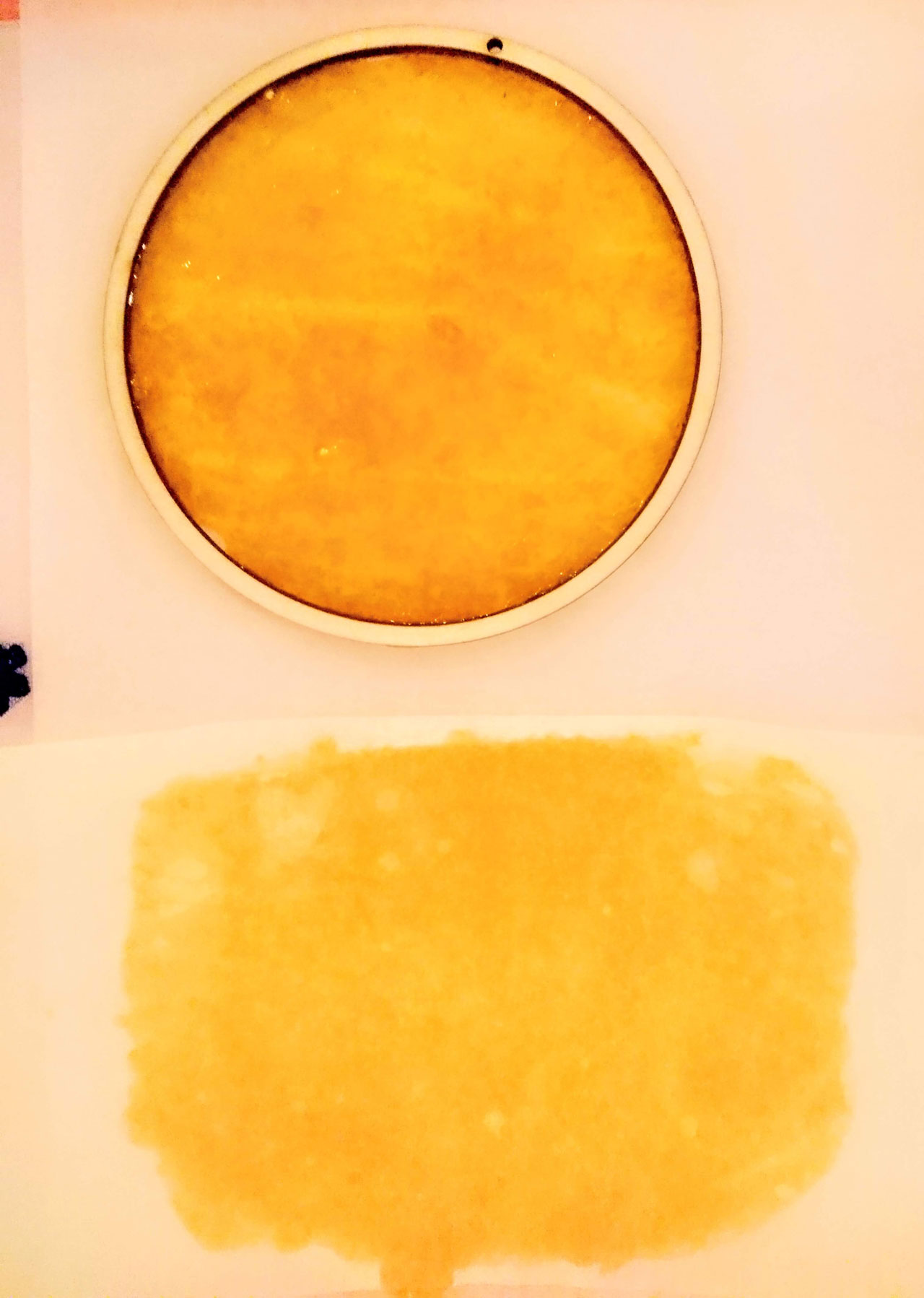
Sunday!!!#
I was sad that I had not tried the recipe for Greta’s bioplastic that I submitted to my thesis. A recipe that excludes gelatine and replaces it with starch of any kind.
I wanted to try it with cornstarch and adding cocoa. I would have liked it to be sweet because another recipe that we have not tried so sad was to make a bioplastic with the wasabi sauce in which to put food to flavor.
Not having the wasabi I decided to think of something sweet since part of my project was a game for children.
So I decided to make a cocoa bowl in which to put orange jellies. Another thing I had never done !!!!
In cooking it after a while the mixture began to thicken, is very sticky and pasty. I laid it on a jar with oil and then laid it out with two sheets of paper.
I took the liberty of cutting it and putting the pieces too much in the dough and then going over it with a rolling pin as if it were pasta.
- Greta bioplastic recipe:
1 part of starch (corn, rice, potatoes, agar agar)
4 parts of water
1/2 part of vinegar
1/2 part of glycerine
To have it sweet I replaced the vinegar with the lemon and orange juice.
The pasta comnicato immediately arompersi as soon as it began to dry.
With the leftover spread between the two sheets of paper I created straps on my mannequin trying to create shots.
The abioplasty has disintegrated, the day after it was not possible to understand its shape.
Even the basin did not hold up.
Perhaps vinegar is essential.
To support it I tried to increase the support on the tips with the paper so as not to leave the material as hanging but it did not help much.


Monday!!! What happend?#
The consistency of my experiment or Greta’s recipe with gelatine replacing starch with a lot of vinegar and grated orange peel seems to me a success.
It is thin, rigid and malleable at the same time. It bends but is not soft and returns to the natural form (extended).
I am so happy that my instinct as always does not betray me! For the moment I love it and I think that the secret is just the vinegar !!!!
From the photos also seems to me that changes the direction of the light is comese made from mirror!

It could be interesting to make some gourmet combinations.

THE CUBES !!!

MY RESULTS !!!

Here we would have to do another test and check if the biggest problem is due to the absence of alcohol or the presence of cocoa. In any case, even the prototypes of Greta were created. This is therefore an aspect to consider.
I still find the solution of adding gelatine instead of starch in this recipe very interesting.

Always because of the excessive humidity the Kombucha made the mold. On Monday afternoon Greta pulled away the mold.
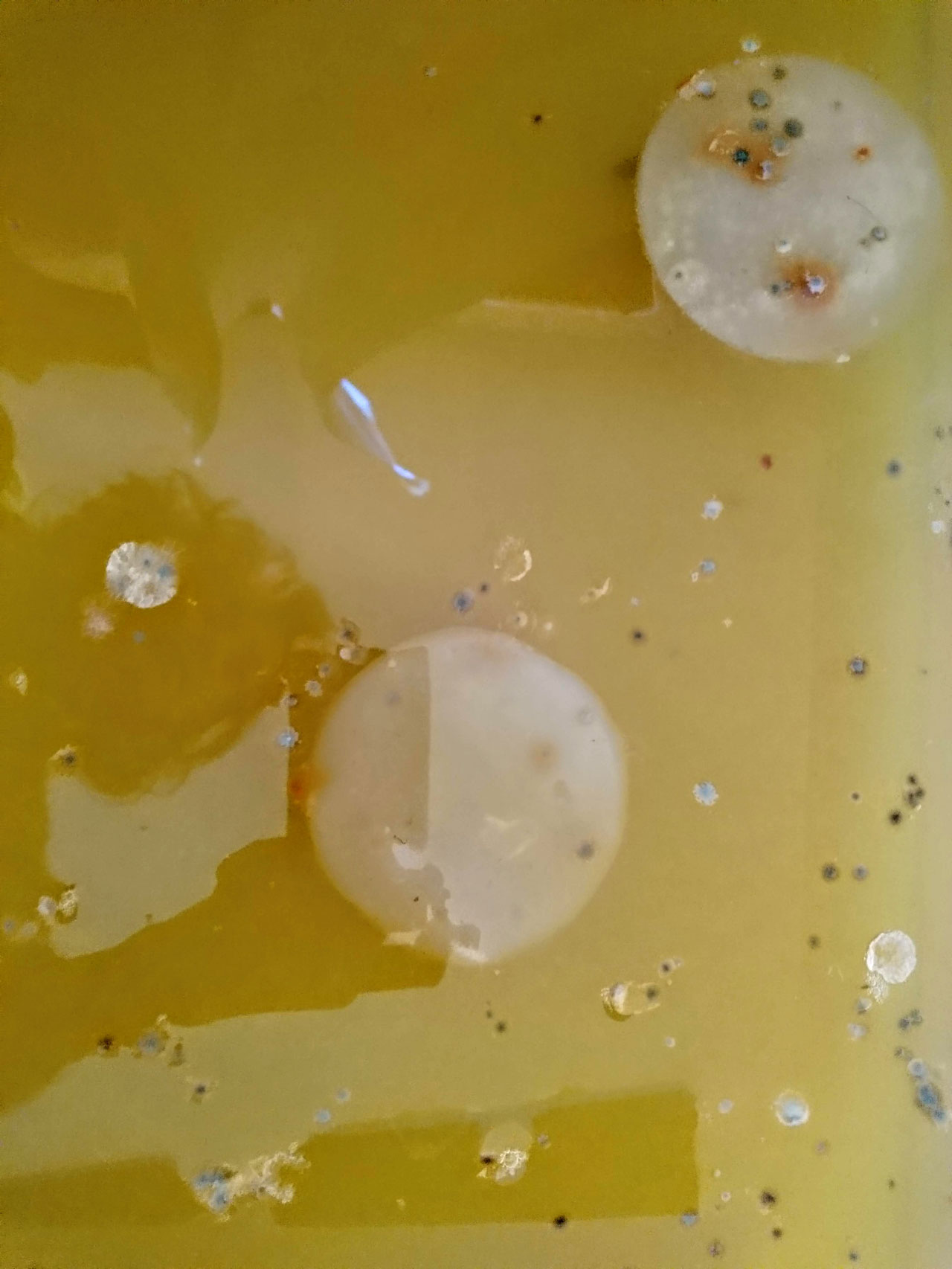
Tuesday#
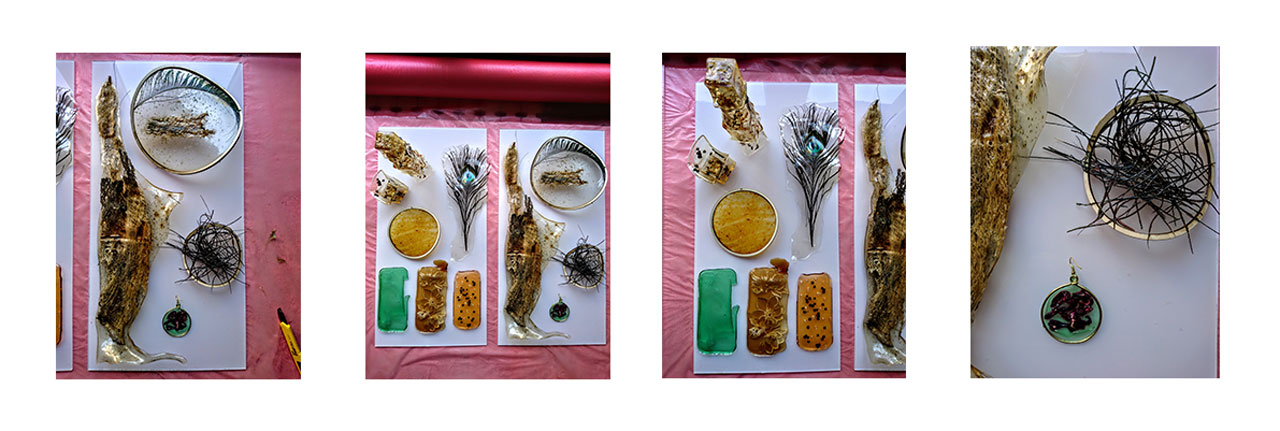
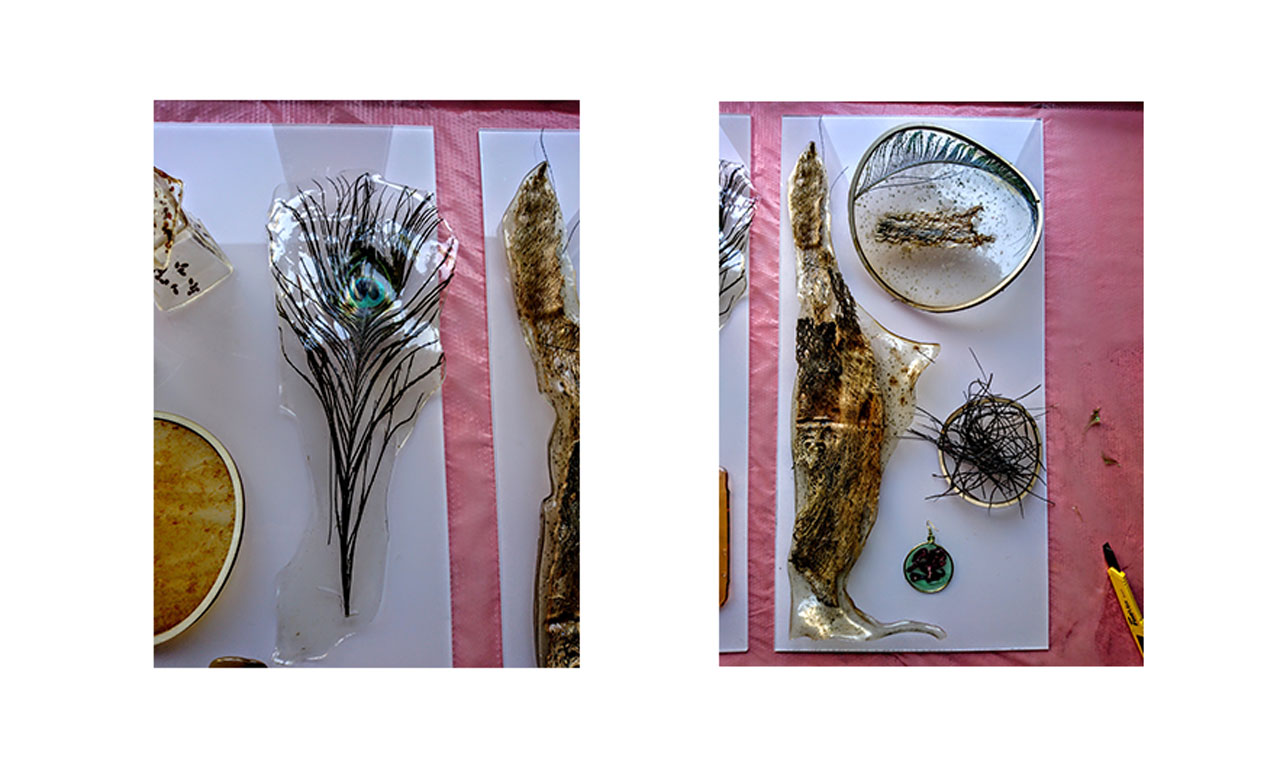
The thick bioplastic was unfortunately initially in an unfavorable position where it did not bathe the sun and has a lot of mold inside while the one with the feathers that is thinner and transparent and rigid.
![]()
they start to dry out and seem to be less rubbery but softer. In trying to dry them faster, the first two melted again with the original shape. I learned another thing....

It turns out to be drier but with a certain manuality still, it does not bend as before but for a while it can still be there I like it very much!
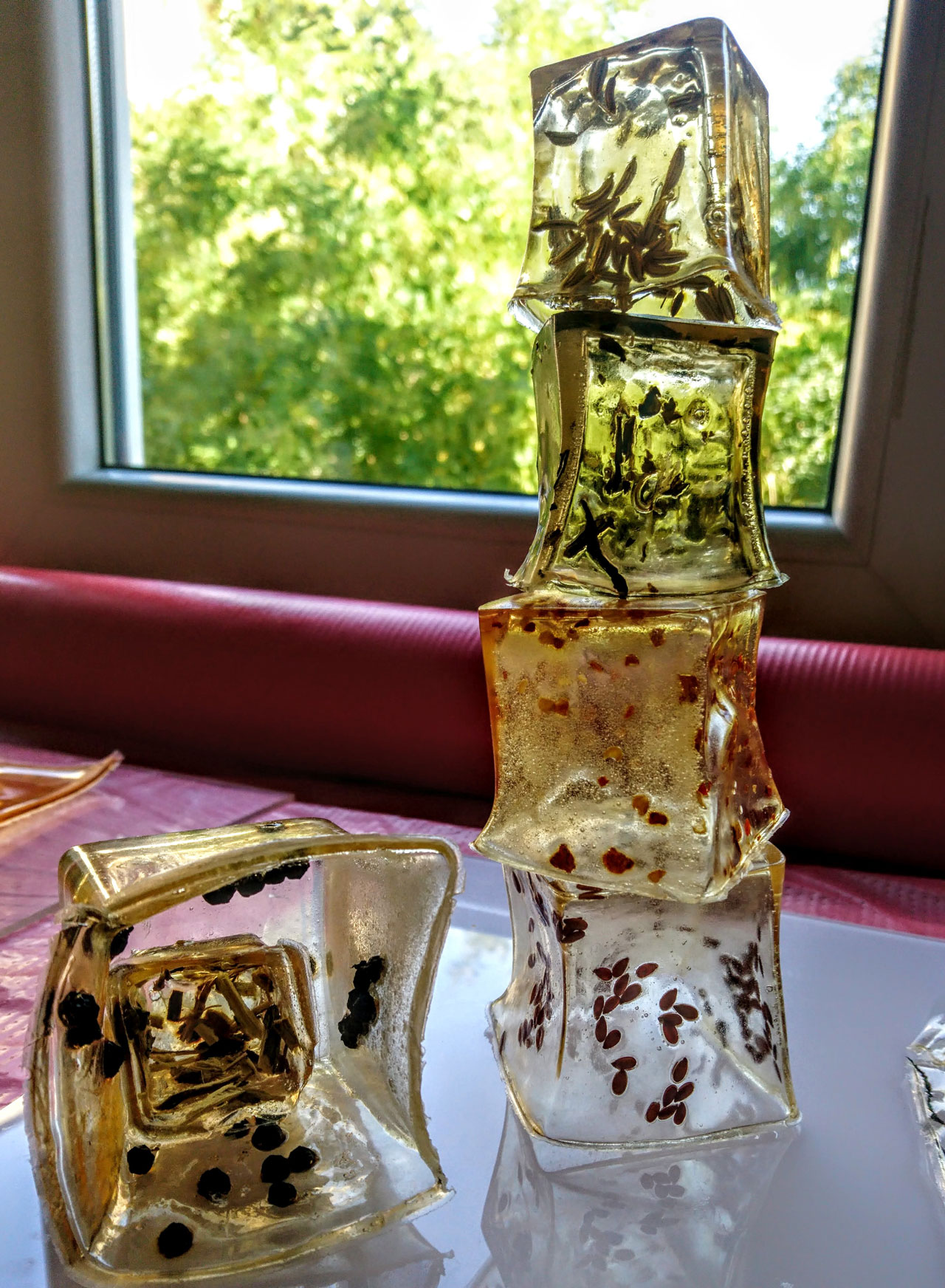
They are not yet completely dry and unfortunately where the resin has dried has deformed and does not make it possible to play well with the joints but the result is still fascinating. I really like the transparency with the colored materials to decorate.
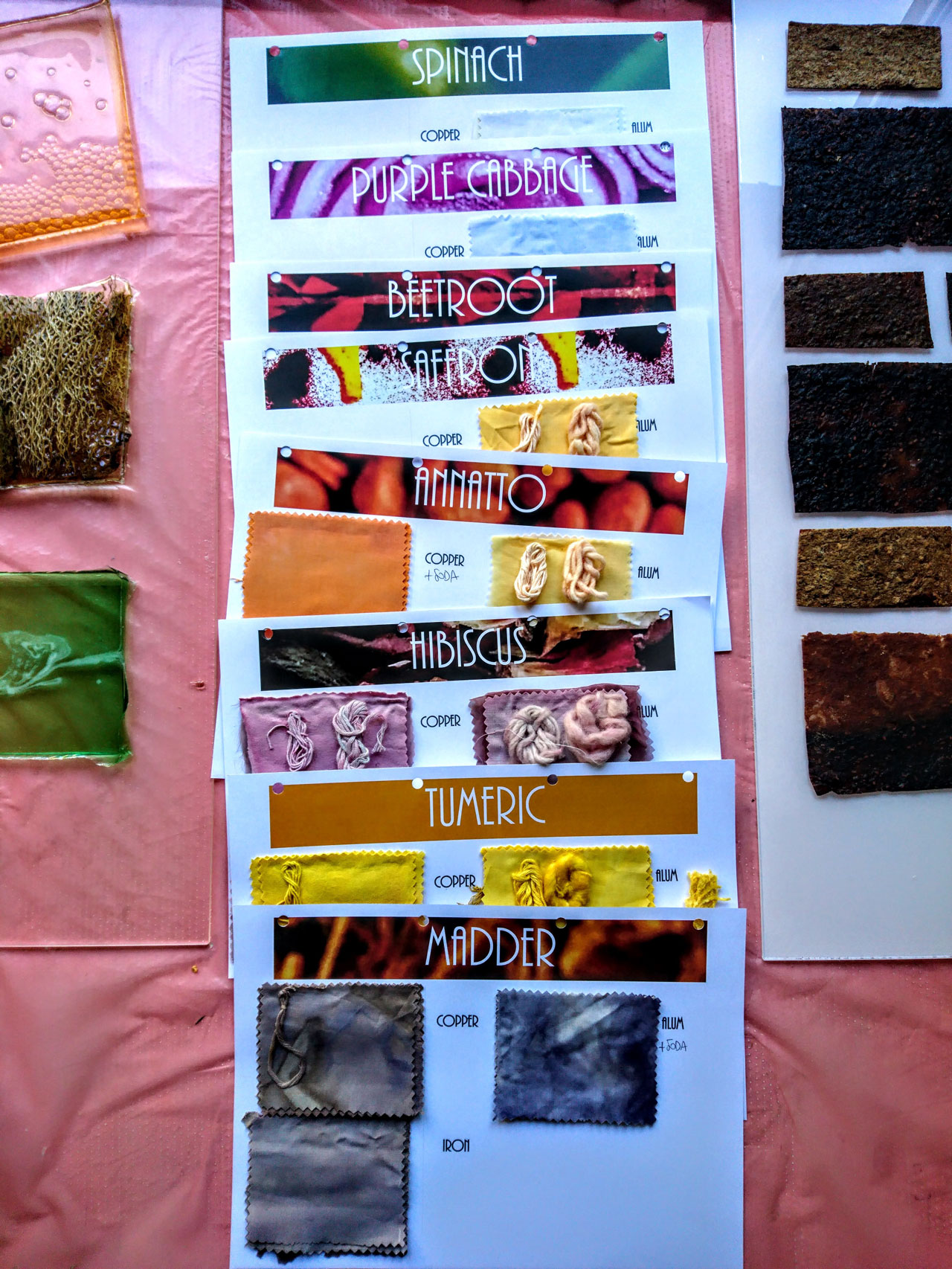
I created a catalog on perforated sheets so I can implement it in the future. I made two identical copies so I could leave one at the WeMake fablab
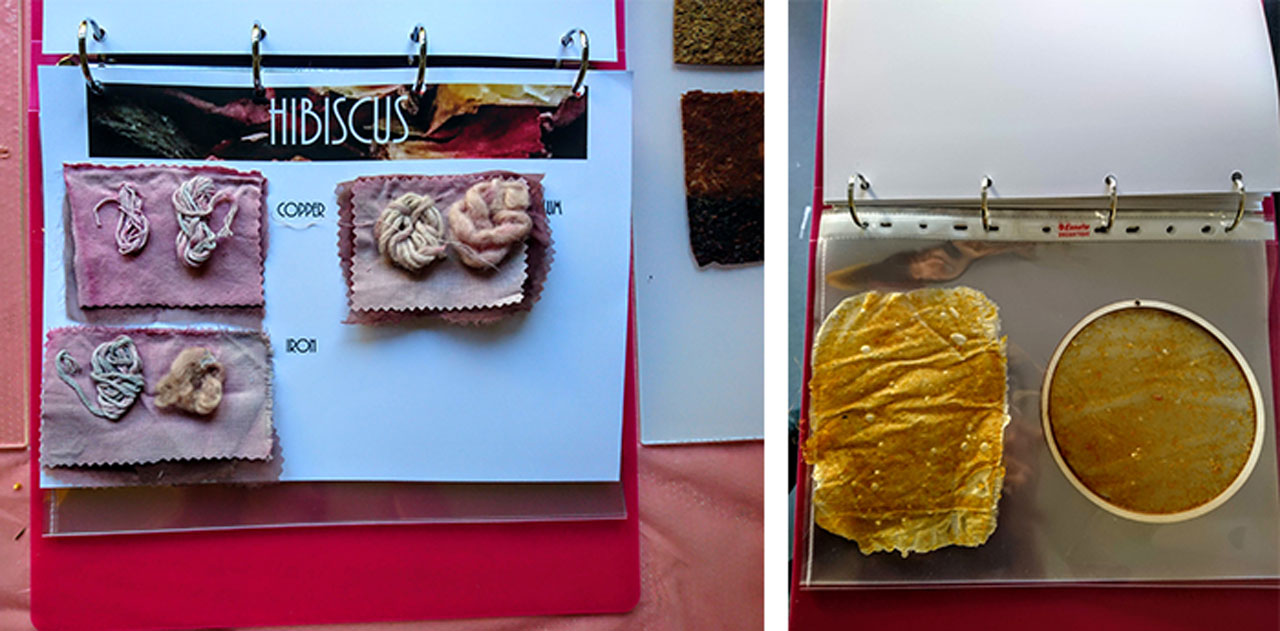
In the binder I decided to also insert the biolastic pieces to create a unique binder with all the experiments !!!! FUXIA !!!